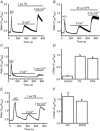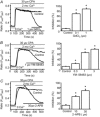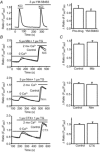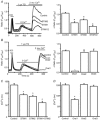Native store-operated calcium channels are functionally expressed in mouse spinal cord dorsal horn neurons and regulate resting calcium homeostasis
- PMID: 24860175
- PMCID: PMC4229342
- DOI: 10.1113/jphysiol.2014.275065
Native store-operated calcium channels are functionally expressed in mouse spinal cord dorsal horn neurons and regulate resting calcium homeostasis
Abstract
Store-operated calcium channels (SOCs) are calcium-selective cation channels that mediate calcium entry in many different cell types. Store-operated calcium entry (SOCE) is involved in various cellular functions. Increasing evidence suggests that impairment of SOCE is responsible for numerous disorders. A previous study demonstrated that YM-58483, a potent SOC inhibitor, strongly attenuates chronic pain by systemic or intrathecal injection and completely blocks the second phase of formalin-induced spontaneous nocifensive behaviour, suggesting a potential role of SOCs in central sensitization. However, the expression of SOCs, their molecular identity and function in spinal cord dorsal horn neurons remain elusive. Here, we demonstrate that SOCs are expressed in dorsal horn neurons. Depletion of calcium stores from the endoplasmic reticulum (ER) induced large sustained calcium entry, which was blocked by SOC inhibitors, but not by voltage-gated calcium channel blockers. Depletion of ER calcium stores activated inward calcium-selective currents, which was reduced by replacing Ca(2+) with Ba(2+) and reversed by SOC inhibitors. Using the small inhibitory RNA knockdown approach, we identified both STIM1 and STIM2 as important mediators of SOCE and SOC current, and Orai1 as a key component of the Ca(2+) release-activated Ca(2+) channels in dorsal horn neurons. Knockdown of STIM1, STIM2 or Orai1 decreased resting Ca(2+) levels. We also found that activation of neurokinin 1 receptors led to SOCE and activation of SOCs produced an excitatory action in dorsal horn neurons. Our findings reveal that a novel SOC signal is present in dorsal horn neurons and may play an important role in pain transmission.
© 2014 The Authors. The Journal of Physiology © 2014 The Physiological Society.
Figures













Similar articles
-
Differential roles for STIM1 and STIM2 in store-operated calcium entry in rat neurons.PLoS One. 2011 Apr 26;6(4):e19285. doi: 10.1371/journal.pone.0019285. PLoS One. 2011. PMID: 21541286 Free PMC article.
-
Orai1 and Orai3 Mediate Store-Operated Calcium Entry Contributing to Neuronal Excitability in Dorsal Root Ganglion Neurons.Front Cell Neurosci. 2017 Dec 19;11:400. doi: 10.3389/fncel.2017.00400. eCollection 2017. Front Cell Neurosci. 2017. PMID: 29311831 Free PMC article.
-
Store-Operated Calcium Entry in Müller Glia Is Controlled by Synergistic Activation of TRPC and Orai Channels.J Neurosci. 2016 Mar 16;36(11):3184-98. doi: 10.1523/JNEUROSCI.4069-15.2016. J Neurosci. 2016. PMID: 26985029 Free PMC article.
-
Molecular physiology and pathophysiology of stromal interaction molecules.Exp Biol Med (Maywood). 2018 Mar;243(5):451-472. doi: 10.1177/1535370218754524. Epub 2018 Jan 24. Exp Biol Med (Maywood). 2018. PMID: 29363328 Free PMC article. Review.
-
Molecular modulators of store-operated calcium entry.Biochim Biophys Acta. 2016 Aug;1863(8):2037-43. doi: 10.1016/j.bbamcr.2016.04.024. Epub 2016 Apr 27. Biochim Biophys Acta. 2016. PMID: 27130253 Review.
Cited by
-
Neuronal P2X7 receptor-induced reactive oxygen species production contributes to nociceptive behavior in mice.Sci Rep. 2017 Jun 14;7(1):3539. doi: 10.1038/s41598-017-03813-7. Sci Rep. 2017. PMID: 28615626 Free PMC article.
-
Role of STIM2 in cell function and physiopathology.J Physiol. 2017 May 15;595(10):3111-3128. doi: 10.1113/JP273889. Epub 2017 Feb 19. J Physiol. 2017. PMID: 28087881 Free PMC article. Review.
-
Neuronal Store-Operated Calcium Channels.Mol Neurobiol. 2023 Aug;60(8):4517-4546. doi: 10.1007/s12035-023-03352-5. Epub 2023 Apr 28. Mol Neurobiol. 2023. PMID: 37118324 Review.
-
Store-Operated Calcium Channels in Physiological and Pathological States of the Nervous System.Front Cell Neurosci. 2020 Nov 26;14:600758. doi: 10.3389/fncel.2020.600758. eCollection 2020. Front Cell Neurosci. 2020. PMID: 33328896 Free PMC article. Review.
-
STIM Proteins: The Gas and Brake of Calcium Entry in Neurons.Neurosci Bull. 2025 Feb;41(2):305-325. doi: 10.1007/s12264-024-01272-5. Epub 2024 Sep 12. Neurosci Bull. 2025. PMID: 39266936 Review.
References
-
- Bakowski D. Parekh AB. Voltage-dependent Ba2+ permeation through store-operated CRAC channels: implications for channel selectivity. Cell Calcium. 2007;42:333–339. - PubMed
-
- Berna-Erro A, Braun A, Kraft R, Kleinschnitz C, Schuhmann MK, Stegner D, Wultsch T, Eilers J, Meuth SG, Stoll G. Nieswandt B. STIM2 regulates capacitive Ca2+ entry in neurons and plays a key role in hypoxic neuronal cell death. Sci Signal. 2009;2:ra67. - PubMed
-
- Bezprozvanny I. Hayden MR. Deranged neuronal calcium signaling and Huntington disease. Biochem Biophys Res Commun. 2004;322:1310–1317. - PubMed
Publication types
MeSH terms
Substances
Grants and funding
LinkOut - more resources
Full Text Sources
Other Literature Sources
Miscellaneous

